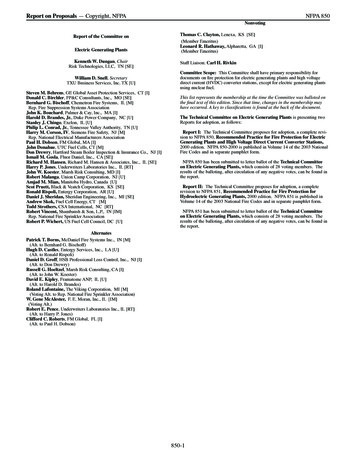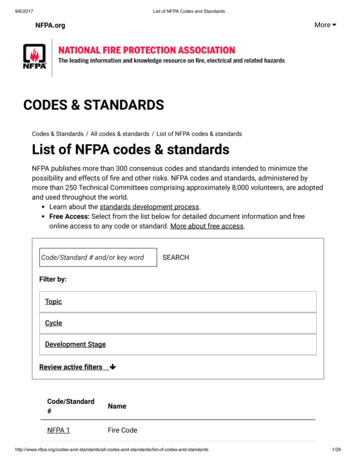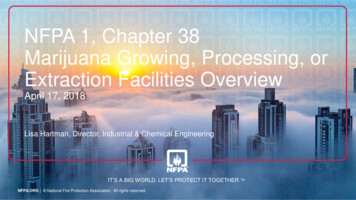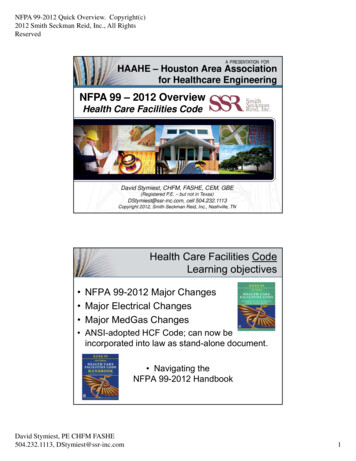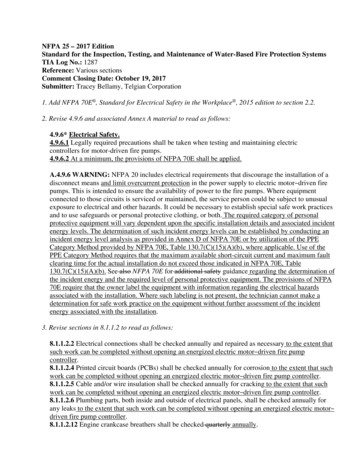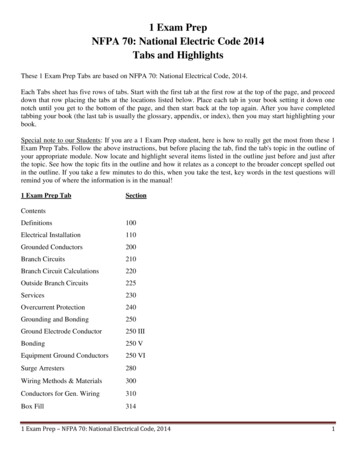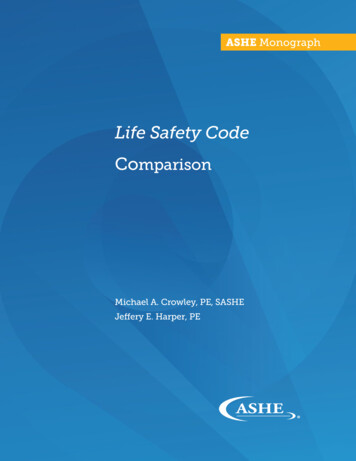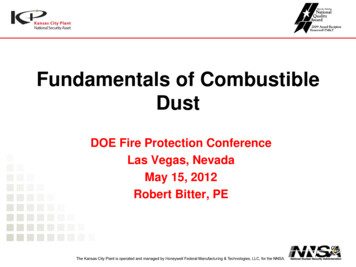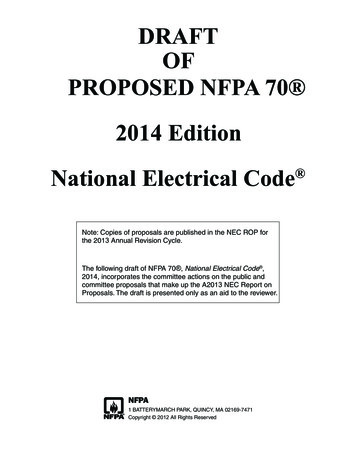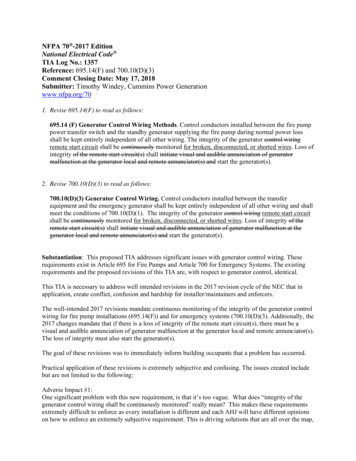
Transcription
NFPA 70 -2017 EditionNational Electrical Code TIA Log No.: 1357Reference: 695.14(F) and 700.10(D)(3)Comment Closing Date: May 17, 2018Submitter: Timothy Windey, Cummins Power Generationwww.nfpa.org/701. Revise 695.14(F) to read as follows:695.14 (F) Generator Control Wiring Methods. Control conductors installed between the fire pumppower transfer switch and the standby generator supplying the fire pump during normal power lossshall be kept entirely independent of all other wiring. The integrity of the generator control wiringremote start circuit shall be continuously monitored for broken, disconnected, or shorted wires. Loss ofintegrity of the remote start circuit(s) shall initiate visual and audible annunciation of generatormalfunction at the generator local and remote annunciator(s) and start the generator(s).2. Revise 700.10(D)(3) to read as follows:700.10(D)(3) Generator Control Wiring. Control conductors installed between the transferequipment and the emergency generator shall be kept entirely independent of all other wiring and shallmeet the conditions of 700.10(D)(1). The integrity of the generator control wiring remote start circuitshall be continuously monitored for broken, disconnected, or shorted wires. Loss of integrity of theremote start circuit(s) shall initiate visual and audible annunciation of generator malfunction at thegenerator local and remote annunciator(s) and start the generator(s).Substantiation: This proposed TIA addresses significant issues with generator control wiring. Theserequirements exist in Article 695 for Fire Pumps and Article 700 for Emergency Systems. The existingrequirements and the proposed revisions of this TIA are, with respect to generator control, identical.This TIA is necessary to address well intended revisions in the 2017 revision cycle of the NEC that inapplication, create conflict, confusion and hardship for installer/maintainers and enforcers.The well-intended 2017 revisions mandate continuous monitoring of the integrity of the generator controlwiring for fire pump installations (695.14(F)) and for emergency systems (700.10(D)(3). Additionally, the2017 changes mandate that if there is a loss of integrity of the remote start circuit(s), there must be avisual and audible annunciation of generator malfunction at the generator local and remote annunciator(s).The loss of integrity must also start the generator(s).The goal of these revisions was to immediately inform building occupants that a problem has occurred.Practical application of these revisions is extremely subjective and confusing. The issues created includebut are not limited to the following:Adverse Impact #1:One significant problem with this new requirement, is that it’s too vague. What does “integrity of thegenerator control wiring shall be continuously monitored” really mean? This makes these requirementsextremely difficult to enforce as every installation is different and each AHJ will have different opinionson how to enforce an extremely subjective requirement. This is driving solutions that are all over the map,
which is adding significant amounts of unnecessary costs and making clear, consistent enforcementimpossible.Adverse Impact #2:Another significant issue resulting from the 2017 revisions, is that no generator manufacturer can do thiswith products that exist today, without adding an extra layer of hardware and wiring which makes theselife safety systems more complicated and less reliable. This is readily seen where simpler start circuitarchitectures are all that is necessary.Adverse Impact #3:Another significant issue is how to get this done. Responsibilities are unclear. For example, is thegenerator manufacturer responsible for the integrity monitoring of the control wiring (which will thenstart the generator and annunciate the alarm), or is it the automatic transfer switch manufacturer, or thesystems integrator, or another party, or a combination of the listed parties? The present text leads tosignificant confusion.Adverse Impact #4:Finally, the requirement for visible and audible annunciation is covered thoroughly in NFPA 110Standard for Emergency and Standby Power Systems. This creates a clear and unmistakable conflictbetween two NFPA documents.This TIA was intentionally delayed until NEC CMP-13 had an opportunity to act on public inputs relatedto the problems addressed in this TIA. The proposed revisions of this TIA reflect the actions taken byCMP-13 during the First Draft meetings in Hilton Head, SC. To solve these problems, CMP-13 deletedthe 2017 revisions and added text that provides clarity for generator remote start circuits.Emergency Nature: This is of an emergency nature due to factor 5.4(e), which states “The proposed TIAintends to correct a circumstance in which the revised NFPA Standard has resulted in an adverse impacton a product or method that was inadvertently overlooked in the total revision process”. Please see thesection above for the multiple adverse impacts.This TIA is necessary to: Provide requirements that are achievable, consistent and enforceable without compromising theselife safety systems by making generator control more complex and less reliable. Eliminate subjective requirements driving solutions that are all over the map. This is necessary toprovide installers, manufacturers and enforcers with clear concise text that is easy to read,practical and enforceable. Provide clear prescriptive requirements to correlate equipment and installation requirements. Eliminate a conflict between NFPA 110 the Standard for Emergency and Standby Power Systemsand the NEC. The requirement for visible and audible annunciation is covered thoroughly inNFPA 110 making the 2017 revisions a clear and unmistakable conflict between two NFPAdocuments.
MEMORANDUMTO:NEC Code-Making Panel 13FROM:Sarah Caldwell, Project AdministratorDATE:May 4, 2018SUBJECT:NFPA 70 Proposed TIA No. 1357 PRELIMINARY TC BALLOTRESULTSAccording to 5.6(a) in the NFPA Regs, the preliminary results show this TIA HAS achievedthe ¾ majority vote needed on both Ballot Item No. 1 (Technical Merit) and Ballot Item No.2 (Emergency Nature).223Eligible to VoteNot Returned (Degnan, Paulsen, Savage, Sr.)Technical Merit:0 Abstentions18 Agree (w/comment: White)1 Disagree (Kovacik)Emergency Nature:0 Abstentions19 Agree0 DisagreeThere are two criteria necessary to pass ballot [(1) simple majority (2) affirmative ¾ vote].Both questions must pass ballot in order to recommend that the Standards Council issue thisTIA.(1)In all cases, an affirmative vote of at least a simple majority of the total membershipeligible to vote is required.[22 eligible 2 11 1 (12)](2)The number of affirmative votes needed to satisfy the ¾ requirement is 15.(22 eligible to vote - 3 not returned - 0 abstentions 19 0.75 14.25)Ballot comments are attached for your review.This proposed TIA has been published for public comment in the April 2018 issue of NFPA Newswith a Public Comment Closing Date of May 17, 2018. Any public comments received will becirculated to the committee.Attachment
NFPA 70 -2017 EditionNational Electrical Code TIA Log No.: 1357Reference: 695.14(F) and 700.10(D)(3)Comment Closing Date: May 17, 2018Submitter: Timothy Windey, Cummins Power Generationwww.nfpa.org/701. Revise 695.14(F) to read as follows:695.14 (F) Generator Control Wiring Methods. Control conductors installed between the fire pumppower transfer switch and the standby generator supplying the fire pump during normal power lossshall be kept entirely independent of all other wiring. The integrity of the generator control wiringremote start circuit shall be continuously monitored for broken, disconnected, or shorted wires. Loss ofintegrity of the remote start circuit(s) shall initiate visual and audible annunciation of generatormalfunction at the generator local and remote annunciator(s) and start the generator(s).2. Revise 700.10(D)(3) to read as follows:700.10(D)(3) Generator Control Wiring. Control conductors installed between the transferequipment and the emergency generator shall be kept entirely independent of all other wiring and shallmeet the conditions of 700.10(D)(1). The integrity of the generator control wiring remote start circuitshall be continuously monitored for broken, disconnected, or shorted wires. Loss of integrity of theremote start circuit(s) shall initiate visual and audible annunciation of generator malfunction at thegenerator local and remote annunciator(s) and start the generator(s).Substantiation: This proposed TIA addresses significant issues with generator control wiring. Theserequirements exist in Article 695 for Fire Pumps and Article 700 for Emergency Systems. The existingrequirements and the proposed revisions of this TIA are, with respect to generator control, identical.This TIA is necessary to address well intended revisions in the 2017 revision cycle of the NEC that inapplication, create conflict, confusion and hardship for installer/maintainers and enforcers.The well-intended 2017 revisions mandate continuous monitoring of the integrity of the generator controlwiring for fire pump installations (695.14(F)) and for emergency systems (700.10(D)(3). Additionally, the2017 changes mandate that if there is a loss of integrity of the remote start circuit(s), there must be avisual and audible annunciation of generator malfunction at the generator local and remote annunciator(s).The loss of integrity must also start the generator(s).The goal of these revisions was to immediately inform building occupants that a problem has occurred.Practical application of these revisions is extremely subjective and confusing. The issues created includebut are not limited to the following:Adverse Impact #1:One significant problem with this new requirement, is that it’s too vague. What does “integrity of thegenerator control wiring shall be continuously monitored” really mean? This makes these requirementsextremely difficult to enforce as every installation is different and each AHJ will have different opinionson how to enforce an extremely subjective requirement. This is driving solutions that are all over the map,
which is adding significant amounts of unnecessary costs and making clear, consistent enforcementimpossible.Adverse Impact #2:Another significant issue resulting from the 2017 revisions, is that no generator manufacturer can do thiswith products that exist today, without adding an extra layer of hardware and wiring which makes theselife safety systems more complicated and less reliable. This is readily seen where simpler start circuitarchitectures are all that is necessary.Adverse Impact #3:Another significant issue is how to get this done. Responsibilities are unclear. For example, is thegenerator manufacturer responsible for the integrity monitoring of the control wiring (which will thenstart the generator and annunciate the alarm), or is it the automatic transfer switch manufacturer, or thesystems integrator, or another party, or a combination of the listed parties? The present text leads tosignificant confusion.Adverse Impact #4:Finally, the requirement for visible and audible annunciation is covered thoroughly in NFPA 110Standard for Emergency and Standby Power Systems. This creates a clear and unmistakable conflictbetween two NFPA documents.This TIA was intentionally delayed until NEC CMP-13 had an opportunity to act on public inputs relatedto the problems addressed in this TIA. The proposed revisions of this TIA reflect the actions taken byCMP-13 during the First Draft meetings in Hilton Head, SC. To solve these problems, CMP-13 deletedthe 2017 revisions and added text that provides clarity for generator remote start circuits.Emergency Nature: This is of an emergency nature due to factor 5.4(e), which states “The proposed TIAintends to correct a circumstance in which the revised NFPA Standard has resulted in an adverse impacton a product or method that was inadvertently overlooked in the total revision process”. Please see thesection above for the multiple adverse impacts.This TIA is necessary to: Provide requirements that are achievable, consistent and enforceable without compromising theselife safety systems by making generator control more complex and less reliable. Eliminate subjective requirements driving solutions that are all over the map. This is necessary toprovide installers, manufacturers and enforcers with clear concise text that is easy to read,practical and enforceable. Provide clear prescriptive requirements to correlate equipment and installation requirements. Eliminate a conflict between NFPA 110 the Standard for Emergency and Standby Power Systemsand the NEC. The requirement for visible and audible annunciation is covered thoroughly inNFPA 110 making the 2017 revisions a clear and unmistakable conflict between two NFPAdocuments.
1(& &2'( 0 .,1* 3 1(/ /(77(5 % //27 352326(' 7(17 7,9( ,17(5,0 0(1'0(17 /2* 12 7R UHYLVH ) DQG UHYLVH ' RI WKH (GLWLRQ RI 1)3 1DWLRQDO (OHFWULFDO &RGH %DOORW ,WHP 1R , DJUHH ZLWK WKH 7(& 1,& / 0(5,76 RI WKH 3URSRVHG 7, WR UHYLVH ) DQG UHYLVH ' BBB;BBBBBBBBB *5(( BBBBBBBBBBBB ',6 *5(( BBBBBBBBBBBB %67 ,1 (;3/ 1 7,21 2) 927( 3OHDVH W\SH RU SULQW \RXU FRPPHQWV Q H[SODQDWLRQ VKDOO DFFRPSDQ\ D ³GLVDJUHH RU ³DEVWDLQ YRWH BBBBBBBBBBBBBBBBBBB BBBBBBBBBBBBBBBBBBB %DOORW ,WHP 1R , *5(( WKDW WKH VXEMHFW LV RI DQ (0(5*(1& 1 785( IRU RQH RU PRUH RI WKH IROORZLQJ UHDVRQV &KHFN DOO WKDW DSSO\ BBBB;BBB 7KH VWDQGDUG FRQWDLQV DQ HUURU RU DQ RPLVVLRQ WKDW ZDV RYHUORRNHG GXULQJ WKH UHJXODU UHYLVLRQ SURFHVV BBBBBBB % 7KH 1)3 6WDQGDUG FRQWDLQV D FRQIOLFW ZLWKLQ WKH 1)3 6WDQGDUG RU ZLWK DQRWKHU 1)3 6WDQGDUG BBBBBBB & 7KH SURSRVHG 7, LQWHQGV WR FRUUHFW D SUHYLRXVO\ XQNQRZQ H[LVWLQJ KD]DUG BBBBBBB ' 7KH SURSRVHG 7, LQWHQGV WR RIIHU WR WKH SXEOLF D EHQHILW WKDW ZRXOG OHVVHQ D UHFRJQL]HG NQRZQ KD]DUG RU DPHOLRUDWH D FRQWLQXLQJ GDQJHURXV FRQGLWLRQ RU VLWXDWLRQ BBBBBBB ( 7KH SURSRVHG 7, LQWHQGV WR DFFRPSOLVK D UHFRJQLWLRQ RI DQ DGYDQFH LQ WKH DUW RI VDIHJXDUGLQJ SURSHUW\ RU OLIH ZKHUH DQ DOWHUQDWLYH PHWKRG LV QRW LQ FXUUHQW XVH RU LV XQDYDLODEOH WR WKH SXEOLF BBBBBBB ) 7KH SURSRVHG 7, LQWHQGV WR FRUUHFW D FLUFXPVWDQFH LQ ZKLFK WKH UHYLVHG 1)3 6WDQGDUG KDV UHVXOWHG LQ DQ DGYHUVH LPSDFW RQ D SURGXFW RU PHWKRG WKDW ZDV LQDGYHUWHQWO\ RYHUORRNHG LQ WKH WRWDO UHYLVLRQ SURFHVV RU ZDV ZLWKRXW DGHTXDWH WHFKQLFDO VDIHW\ MXVWLILFDWLRQ IRU WKH DFWLRQ BBBBBBBBBBBB %67 ,1 BBBBBBBBBBBB ',6 *5(( 7KH 7, GRHV QRW PHHW DQ\ RI WKH UHJXODWLRQV DERYH ZDUUDQWLQJ D 7, WKHUHIRUH WKH 7, LV 127 RI HPHUJHQF\ QDWXUH (;3/ 1 7,21 2) 927( 3OHDVH W\SH RU SULQW \RXU FRPPHQWV Q H[SODQDWLRQ PXVW DFFRPSDQ\ D ³GLVDJUHH RU ³DEVWDLQ YRWH BBBBBBBBBBBBBBBBBBB BBBBBBBBBBBBBBBBBBB BBBBBBB/DUU\ \HU BBBBBBBBBBBBBBBBBB 6LJQDWXUH BBBBBBBB BBBBBBBBBBBBB 'DWH
BBBBB/DUU\ \HUBBBBBBBBBBBBBBBBBBBBBBBBBBB 1DPH 3OHDVH 3ULQW 3OHDVH UHWXUQ WKH EDOORW RQ RU EHIRUH 7XHVGD\ SULO 3/( 6( 5(7851 72 6DUDK &DOGZHOO 7HFKQLFDO &RPPLWWHH GPLQLVWUDWRU 1)3 %DWWHU\PDUFK 3DUN 4XLQF\ 0 ) ; ( PDLO VFDOGZHOO#QISD RUJ
NEC CODE-MAKING PANEL 13 LETTER BALLOTPROPOSED TENTATIVE INTERIM AMENDMENT LOG NO. 1357To revise 695.14(F) and revise 700.10(D)(3) of the 2017 Edition ofNFPA 70, National Electrical Code Ballot Item No. 1:I agree with the TECHNICAL MERITS of the Proposed TIA to revise 695.14(F) and revise 700.10(D)(3)X AGREEDISAGREE*ABSTAIN*EXPLANATION OF VOTE - Please type or print your comments:*An explanation shall accompany a “disagree” or “abstain” vote.Ballot Item No. 2:I AGREE that the subject is of an EMERGENCY NATURE* for one or more of the following reasons (Check all thatapply):XA.The standard contains an error or an omission that was overlooked during the regular revisionprocess.XB.The NFPA Standard contains a conflict within the NFPA Standard or with another NFPAStandard.C.The proposed TIA intends to correct a previously unknown existing hazard.D.The proposed TIA intends to offer to the public a benefit that would lessen a recognized (known)hazard or ameliorate a continuing dangerous condition or situation.E.The proposed TIA intends to accomplish a recognition of an advance in the art of safeguardingproperty or life where an alternative method is not in current use or is unavailable to the public.XF.The proposed TIA intends to correct a circumstance in which the revised NFPA Standard hasresulted in an adverse impact on a product or method that was inadvertently overlooked in thetotal revision process or was without adequate technical (safety) justification for the action.ABSTAINDISAGREE The TIA does not meet any of the regulations above warranting a TIA, therefore the TIA isNOT of emergency natureEXPLANATION OF VOTE - Please type or print your comments:* An explanation must accompany a “disagree” or “abstain” vote.April 24, 2018SignatureDate
Steve BaldwinName (Please Print)Please return the ballot on or before Tuesday, April 24, 2018.PLEASE RETURN TO:Sarah Caldwell, Technical Committee AdministratorNFPA1 Batterymarch ParkQuincy, MA 02169FAX: (617) 984-7110E-mail: scaldwell@nfpa.org
NEC CODE-MAKING PANEL 13 LETTER BALLOTPROPOSED TENTATIVE INTERIM AMENDMENT LOG NO. 1357To revise 695.14(F) and revise 700.10(D)(3) of the 2017 Edition ofNFPA 70, National Electrical Code Ballot Item No. 1:I agree with the TECHNICAL MERITS of the Proposed TIA to revise 695.14(F) and revise 700.10(D)(3)X AGREEDISAGREE*ABSTAIN*EXPLANATION OF VOTE - Please type or print your comments:*An explanation shall accompany a “disagree” or “abstain” vote.Ballot Item No. 2:I AGREE that the subject is of an EMERGENCY NATURE* for one or more of the following reasons (Check all thatapply):A.The standard contains an error or an omission that was overlooked during the regular revisionprocess.XB.The NFPA Standard contains a conflict within the NFPA Standard or with another NFPAStandard.C.The proposed TIA intends to correct a previously unknown existing hazard.D.The proposed TIA intends to offer to the public a benefit that would lessen a recognized (known)hazard or ameliorate a continuing dangerous condition or situation.E.The proposed TIA intends to accomplish a recognition of an advance in the art of safeguardingproperty or life where an alternative method is not in current use or is unavailable to the public.XF.The proposed TIA intends to correct a circumstance in which the revised NFPA Standard hasresulted in an adverse impact on a product or method that was inadvertently overlooked in thetotal revision process or was without adequate technical (safety) justification for the action.ABSTAINDISAGREE The TIA does not meet any of the regulations above warranting a TIA, therefore the TIA isNOT of emergency natureEXPLANATION OF VOTE - Please type or print your comments:* An explanation must accompany a “disagree” or “abstain” vote.Signature4/20/2018Date
Greg J. BallName (Please Print)Please return the ballot on or before Tuesday, April 24, 2018.PLEASE RETURN TO:Sarah Caldwell, Technical Committee AdministratorNFPA1 Batterymarch ParkQuincy, MA 02169FAX: (617) 984-7110E-mail: scaldwell@nfpa.org
1(& &2'( 0 .,1* 3 1(/ /(77(5 % //27 352326(' 7(17 7,9( ,17(5,0 0(1'0(17 /2* 12 7R UHYLVH ) DQG UHYLVH ' RI WKH (GLWLRQ RI 1)3 1DWLRQDO (OHFWULFDO &RGH %DOORW ,WHP 1R , DJUHH ZLWK WKH 7(& 1,& / 0(5,76 RI WKH 3URSRVHG 7, WR UHYLVH ) DQG UHYLVH ' BBB;;;BBBBBBBBB *5(( BBBBBBBBBBBB ',6 *5(( BBBBBBBBBBBB %67 ,1 (;3/ 1 7,21 2) 927( 3OHDVH W\SH RU SULQW \RXU FRPPHQWV Q H[SODQDWLRQ VKDOO DFFRPSDQ\ D ³GLVDJUHH RU ³DEVWDLQ YRWH BBBBBBBBBBBBBBBBBBB BBBBBBBBBBBBBBBBBBB %DOORW ,WHP 1R , *5(( WKDW WKH VXEMHFW LV RI DQ (0(5*(1& 1 785( IRU RQH RU PRUH RI WKH IROORZLQJ UHDVRQV &KHFN DOO WKDW DSSO\ BBBBBBB 7KH VWDQGDUG FRQWDLQV DQ HUURU RU DQ RPLVVLRQ WKDW ZDV RYHUORRNHG GXULQJ WKH UHJXODU UHYLVLRQ SURFHVV BBBBBBB % 7KH 1)3 6WDQGDUG FRQWDLQV D FRQIOLFW ZLWKLQ WKH 1)3 6WDQGDUG RU ZLWK DQRWKHU 1)3 6WDQGDUG BBBBBBB & 7KH SURSRVHG 7, LQWHQGV WR FRUUHFW D SUHYLRXVO\ XQNQRZQ H[LVWLQJ KD]DUG BBBBBBB ' 7KH SURSRVHG 7, LQWHQGV WR RIIHU WR WKH SXEOLF D EHQHILW WKDW ZRXOG OHVVHQ D UHFRJQL]HG NQRZQ KD]DUG RU DPHOLRUDWH D FRQWLQXLQJ GDQJHURXV FRQGLWLRQ RU VLWXDWLRQ BBBBBBB ( 7KH SURSRVHG 7, LQWHQGV WR DFFRPSOLVK D UHFRJQLWLRQ RI DQ DGYDQFH LQ WKH DUW RI VDIHJXDUGLQJ SURSHUW\ RU OLIH ZKHUH DQ DOWHUQDWLYH PHWKRG LV QRW LQ FXUUHQW XVH RU LV XQDYDLODEOH WR WKH SXEOLF B;;;BB ) 7KH SURSRVHG 7, LQWHQGV WR FRUUHFW D FLUFXPVWDQFH LQ ZKLFK WKH UHYLVHG 1)3 6WDQGDUG KDV UHVXOWHG LQ DQ DGYHUVH LPSDFW RQ D SURGXFW RU PHWKRG WKDW ZDV LQDGYHUWHQWO\ RYHUORRNHG LQ WKH WRWDO UHYLVLRQ SURFHVV RU ZDV ZLWKRXW DGHTXDWH WHFKQLFDO VDIHW\ MXVWLILFDWLRQ IRU WKH DFWLRQ BBBBBBBBBBBB %67 ,1 BBBBBBBBBBBB ',6 *5(( 7KH 7, GRHV QRW PHHW DQ\ RI WKH UHJXODWLRQV DERYH ZDUUDQWLQJ D 7, WKHUHIRUH WKH 7, LV 127 RI HPHUJHQF\ QDWXUH (;3/ 1 7,21 2) 927( 3OHDVH W\SH RU SULQW \RXU FRPPHQWV Q H[SODQDWLRQ PXVW DFFRPSDQ\ D ³GLVDJUHH RU ³DEVWDLQ YRWH BBBBBBBBBBBBBBBBBBB BBBBBBBBBBBBBBBBBBB 6LJQDWXUH BBBBBBBBBBBBBBBBBBBBBBBBBBBBBB BBBBBBBBBBBBB 'DWH
'DQLHO - &DURQ BBBBBBBBBBBBBBBBBBBBBBBBBBBBBBBB 1DPH 3OHDVH 3ULQW 3OHDVH UHWXUQ WKH EDOORW RQ RU EHIRUH 7XHVGD\ SULO 3/( 6( 5(7851 72 6DUDK &DOGZHOO 7HFKQLFDO &RPPLWWHH GPLQLVWUDWRU 1)3 %DWWHU\PDUFK 3DUN 4XLQF\ 0 ) ; ( PDLO VFDOGZHOO#QISD RUJ
NEC CODE-MAKING PANEL 13 LETTER BALLOTPROPOSED TENTATIVE INTERIM AMENDMENT LOG NO. 1357To revise 695.14(F) and revise 700.10(D)(3) of the 2017 Edition ofNFPA 70, National Electrical Code Ballot Item No. 1:I agree with the TECHNICAL MERITS of the Proposed TIA to revise 695.14(F) and revise 700.10(D)(3)X AGREEDISAGREE*ABSTAIN*EXPLANATION OF VOTE - Please type or print your comments:*An explanation shall accompany a “disagree” or “abstain” vote.Ballot Item No. 2:I AGREE that the subject is of an EMERGENCY NATURE* for one or more of the following reasons (Check all thatapply):A.The standard contains an error or an omission that was overlooked during the regular revisionprocess.XB.The NFPA Standard contains a conflict within the NFPA Standard or with another NFPAStandard.C.The proposed TIA intends to correct a previously unknown existing hazard.D.The proposed TIA intends to offer to the public a benefit that would lessen a recognized (known)hazard or ameliorate a continuing dangerous condition or situation.E.The proposed TIA intends to accomplish a recognition of an advance in the art of safeguardingproperty or life where an alternative method is not in current use or is unavailable to the public.XF.The proposed TIA intends to correct a circumstance in which the revised NFPA Standard hasresulted in an adverse impact on a product or method that was inadvertently overlooked in thetotal revision process or was without adequate technical (safety) justification for the action.ABSTAINDISAGREE The TIA does not meet any of the regulations above warranting a TIA, therefore the TIA isNOT of emergency natureEXPLANATION OF VOTE - Please type or print your comments:* An explanation must accompany a “disagree” or “abstain” vote.
11 April 2018SignatureDateNEIL CZARNECKIName (Please Print)Please return the ballot on or before Tuesday, April 24, 2018.PLEASE RETURN TO:Sarah Caldwell, Technical Committee AdministratorNFPA1 Batterymarch ParkQuincy, MA 02169FAX: (617) 984-7110E-mail: scaldwell@nfpa.org
NEC CODE-MAKING PANEL 13 LETTER BALLOTPROPOSED TENTATIVE INTERIM AMENDMENT LOG NO. 1357To revise 695.14(F) and revise 700.10(D)(3) of the 2017 Edition ofNFPA 70, National Electrical Code Ballot Item No. 1:I agree with the TECHNICAL MERITS of the Proposed TIA to revise 695.14(F) and revise 700.10(D)(3)x AGREEDISAGREE*ABSTAIN*EXPLANATION OF VOTE - Please type or print your comments:*An explanation shall accompany a “disagree” or “abstain” vote.Ballot Item No. 2:I AGREE that the subject is of an EMERGENCY NATURE* for one or more of the following reasons (Check all thatapply):xA.The standard contains an error or an omission that was overlooked during the regular revisionprocess.xB.The NFPA Standard contains a conflict within the NFPA Standard or with another NFPAStandard.xC.The proposed TIA intends to correct a previously unknown existing hazard.xD.The proposed TIA intends to offer to the public a benefit that would lessen a recognized (known)hazard or ameliorate a continuing dangerous condition or situation.xE.The proposed TIA intends to accomplish a recognition of an advance in the art of safeguardingproperty or life where an alternative method is not in current use or is unavailable to the public.xF.The proposed TIA intends to correct a circumstance in which the revised NFPA Standard hasresulted in an adverse impact on a product or method that was inadvertently overlooked in thetotal revision process or was without adequate technical (safety) justification for the action.ABSTAINDISAGREE The TIA does not meet any of the regulations above warranting a TIA, therefore the TIA isNOT of emergency natureEXPLANATION OF VOTE - Please type or print your comments:* An explanation must accompany a “disagree” or “abstain” vote.Robert JordanSignature4/11/18Date
Robert JordanName (Please Print)Please return the ballot on or before Tuesday, April 24, 2018.PLEASE RETURN TO:Sarah Caldwell, Technical Committee AdministratorNFPA1 Batterymarch ParkQuincy, MA 02169FAX: (617) 984-7110E-mail: scaldwell@nfpa.org
NEC CODE-MAKING PANEL 13 LETTER BALLOTPROPOSED TENTATIVE INTERIM AMENDMENT LOG NO. 1357To revise 695.14(F) and revise 700.10(D)(3) of the 2017 Edition ofNFPA 70, National Electrical Code Ballot Item No. 1:I agree with the TECHNICAL MERITS of the Proposed TIA to revise 695.14(F) and revise 700.10(D)(3)AGREEX DISAGREE*ABSTAIN*EXPLANATION OF VOTE - Please type or print your comments:*An explanation shall accompany a “disagree” or “abstain” vote.Please refer to the explanation below.Ballot Item No. 2:I AGREE that the subject is of an EMERGENCY NATURE* for one or more of the following reasons (Check all thatapply):A.The standard contains an error or an omission that was overlooked during the regular revisionprocess.B.The NFPA Standard contains a conflict within the NFPA Standard or with another NFPAStandard.C.The proposed TIA intends to correct a previously unknown existing hazard.D.The proposed TIA intends to offer to the public a benefit that would lessen a recognized (known)hazard or ameliorate a continuing dangerous condition or situation.E.The proposed TIA intends to accomplish a recognition of an advance in the art of safeguardingproperty or life where an alternative method is not in current use or is unavailable to the public.XF.The proposed TIA intends to correct a circumstance in which the revised NFPA Standard hasresulted in an adverse impact on a product or method that was inadvertently overlooked in thetotal revision process or was without adequate technical (safety) justification for the action.ABSTAINDISAGREE The TIA does not meet any of the regulations above warranting a TIA, therefore the TIA isNOT of emergency natureEXPLANATION OF VOTE - Please type or print your comments:* An explanation must accompany a “disagree” or “abstain” vote.
SignatureApril 12, 2018DateJohn KovacikName (Please Print)Please return the ballot on or before Tuesday, April 24, 2018.PLEASE RETURN TO:Sarah Caldwell, Technical Committee AdministratorNFPA1 Batterymarch ParkQuincy, MA 02169FAX: (617) 984-7110E-mail: scaldwell@nfpa.orgExplanation of Negative Vote for Technical Merits:I agree that changes are needed to address the well-intended revisions in the 2017 revision cycle of the NECthat in application, create conflict, confusion and hardship for installer/maintainers and enforcers. However, I donot agree with the revisions being proposed in this TIA.The revisions in the 2017 cycle attempted to improve the “integrity” of the wiring of the remote start circuit(s)by introducing the need for continuous monitoring of the circuits. Providing this capability has been a technicalchallenge for generator and transfer switch manufacturers. The intent and application of these revisions weretaken up in a recent discussion with several fire pump controller manufacturers. The discussion ended in arecommendation to delete the last two sentences of 695.14(F) and 700.10(D)(3) as shown below.695.14(F) Generator Control Wiring Methods. Control conductors installed between the fire pump powertransfer switch and the standby generator supplying the fire pump during normal power loss shall be keptentirely independent of all other wiring. The integrity of the generator control wiring shall be continuouslymonitored. Loss of integrity of the remote start circuit(s) shall initiate visual and audible annunciation ofgenerator malfunction at the generator local and remote annunciator(s) and start the generator(s).700.10(D)(3) Generator Control Wiring. Control conductors installed between the transfer equipment and theemergency generator shall be kept entirely independent of all other wiring and shall meet the conditions of700.10(D)(1). The integrity of the generator control wiring shall be continuously mon
NFPA 70 -2017 Edition National Electrical Code TIA Log No.: 1357 Reference: 695.14(F) and 700.10(D)(3
